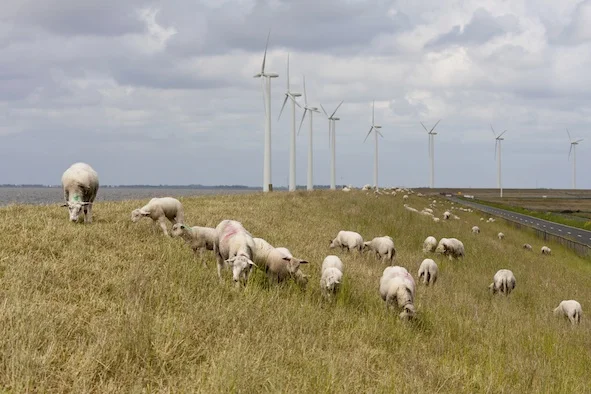Wind is moving air.
We can't see the wind but we can feel it and see what is does.
Winds can be strong and dangerous.
The wind’s energy can be used to make electricity.
What is wind?
As the heat energy of the sun warms the air around the earth, the air expands and rises. As it rises, the air cools and becomes heavier. The cooler air moves down and under warm air. This moving air is called wind.
When wind moves gently, it is called a breeze. It can blow harder too. When the winds are very strong they can become gales and storms. Very strong winds can become hurricanes, typhoons, cyclones and tornadoes.
These can cause floods and other disasters.
Measuring the wind
The Beaufort Wind Scale
This is one way that the strength of the wind is measured. The scale is named after Sir Francis Beaufort, who developed it in 1805 for use by sailors.
You can use the Beaufort scale to measure the force of the wind by looking at the effects of the wind on things around you.
Force 0
Calm: 0 km per hour
Smoke rises vertically
Force 1
Light air: 1-5 km per hour
Smoke blown by wind
Force 2
Light breeze: 6-11 km per hour
Leaves rustle, you feel the wind on your face
Force 3
Gentle breeze: 12-19 km per hour
Leaves and twigs on trees moving constantly. Flags flutter
Force 4
Moderate breeze: 20-30 km per hour
Wind raise dust and fallen leaves. Paper blows around. Small tree branches sway
Force 5
Fresh breeze: 31-39 km per hour
Small trees begin to sway
Force 6
Strong breeze: 40-50 km per hour
Large branches sway. Umbrellas hard to hold, blown inside out
Force 7
Near gale: 51-61 km per hour
Whole trees sway. You can feel the wind pushing you
Force 8
Gale: 62-74 km per hour
Difficult to walk in the wind. Twigs and small branches broken off trees
Force 9
Strong gale: 75-87 km per hour
Tiles blown off roofs, large tree branches blown down
Force 10
Storm: 88-102 km per hour
Damage to houses. Whole trees broken or blown over
Force 11
Violent storm: 102-116 km per hour
Serious damage to buildings, trees uprooted
Force 12
Cyclone: 117-132 km per hour
Widespread and very severe damage
Sir Francis Beaufort invented a way of measuring the strength of wind
Yachts are moved by the energy of the wind. Yachts are sailed for recreation and leisure. Getty Images
Using the power of the wind
Humans have used the power of the wind for centuries. To sail their ships, to grind grain to make flour and to pump water.
We still use the energy of the wind for leisure and industry. Winds move boats and propel hang gliders, parasails and hot air balloons. Wind energy is used to generate electricity, pump water, grind grain and dry the washing. Flying kites would be impossible without the power of the wind.
Wind turbines ©Jupiter Images
Wind energy becomes electrical energy
A wind turbine is made up of two or three propeller-like blades called the rotor. The rotor is attached to the top of a tall tower. As the wind blows it spins the rotor. As the rotor spins the energy of the movement of the propellers gives power to a generator. There are some magnets and a lot of copper wire inside the generator that make electricity.
Wind turbines along a high ridge. ©Jupiter Images
Winds are stronger higher up off the ground, so wind turbine towers are about 30 metres tall to allow the rotor to catch more wind energy. The turbines are built with a device that turns the rotor so that it always faces into the wind. Just one wind turbine can generate enough electricity for a single house, or the electrical energy to pump water, or to power a mill which grinds grain. The electrical energy can also be stored in batteries. Or it is sent to cables that carry the electricity to our houses and to factories where it powers machines.
Wind turbines are pollution free © Getty Images
Wind farms
Wind farms are places where many wind turbines are clustered together. They are built in places where it is nearly always windy. The electricity that is generated at a wind farm is sold to electricity companies that provide the electricity to people living in cities and towns.
What are the advantages of wind turbines?
They are pollution free.
The energy they generate is renewable. This means that as long as the winds blow there is power to turn the blades of the rotor. (Another form of renewable energy comes from the Sun. Energy from the Sun is called solar energy)
Using wind energy means that less fossil fuel (coal and oil) needs to be burned to make electricity. Burning fossil fuel pollutes the atmosphere and adds greenhouse gases to it. This pollution is a cause of global warming.
What are the disadvantages of wind turbines?
Some people don't like the look of the turbines. They say that they spoil the look of the natural environment.
Wind turbines make some noise.
Turbines kill birds that fly into them. However collisions are rare and there are reports from Denmark saying that some falcons had built nests on the top of turbine towers. To protect birds however, it is important that wind farms be built away from bird sanctuaries and from the pathways of migratory birds. (Migratory birds are those that fly from cold places in winter to warmer parts of the world)







